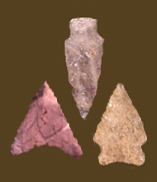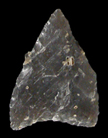
|
JACK'S REEF PENTAGONAL
Chronology The Jack’s Reef Pentagonal point dates to the Middle and Late Woodland periods. Wall et al. (1996) state that the type has been radiocarbon dated between 310 and 955 AD (approximately 400-1000 AD in calendar years). Justice (1987:217) suggests the type appears in the Northeast around 500 AD and disappears around 1000 AD. A radiocarbon date of 1560 +/- 25 BP (488 AD calendar) came from a Jack’s Reef midden at the Upper Ridge site on the Virginia Eastern Shore, and the nearby Mockhorn #12 site produced similar dates (Lowery 2013). Custer (1996a) notes that radiocarbon dates from the Island Field site in Delaware, as well as elsewhere in the region, indicate a range of 600 to 900 AD (650-975 AD in calendar years). Coe (1995) recovered more than 10,000 of the very similar Pee Dee Pentagonal points from North Carolina’s Town Creek site, which he dates from 1000 to 1300 AD. In general, the dates for Jack’s Reef points seem to be earlier in the Northeast than they are farther to the south and west. Description Blade: Pentagonal in form, with straight sides (sometimes slightly contracting), usually asymmetrical. Haft Element: The base is usually straight, but can be concave. Size: Length ranges from 25 to 44 mm, although occasional larger specimens (over 200 mm) have been found (Custer 1996). Typical width is 19 to 33 mm. The maximum thickness is about 5 to 6 mm. Technique of manufacture: Refined pressure flaking on a thin primary flake. Material: In a sample of 131 Jack’s Reef Pentagonal points from the lower Patuxent drainage, Steponaitis (1980) reported that 53% were quartz, followed by rhyolite (28%), quartzite (11%), chert (5%), argillite (2%), and jasper (1%). In the area surrounding Zekiah Swamp on the lower Potomac, Wanser (1982) found that 46% of 13 Jack’s Reef Pentagonal points were quartzite, followed by quartz (15%), rhyolite (15%), chert (8%), and other materials (15%). In the Monocacy River drainage, 57% of 42 Jack’s Reef Pentagonals were quartz, with 29% chalcedony and 7% each of chert and rhyolite (Kavanagh 1982). In the Hagerstown Valley, a majority of Jack’s Reef Pentagonal points were chert, with the rest rhyolite (Stewart 1980). Jasper and chert Jack’s Reef points predominate in the middle Potomac River Valley, but quartzite and rhyolite sometimes occur (Hranicky 2002). In Delaware, 99% of Jack’s Reef points are jasper (Custer 1996a), and a pronounced preference for jasper has been noted throughout the Delmarva Peninsula (Lowery 2013). Discussion Jack’s Reef Pentagonal and Jack’s Reef Corner Notched are related and contemporary points. They are found across the Northeast, the eastern Great Lakes, and the Upper South (Justice 1987). Lowery (2013) suggests Jack’s Reef cultures may have originated along the Atlantic Coast around 500 AD and spread westward. The Pentagonal points are much more common than the Corner Notched ones along the Patuxent and Potomac drainages. Steponaitis (1980) recorded 131 Pentagonal points but only 2 Corner Notched ones along the lower Patuxent. Wanser (1982) noted 13 Pentagonal but no Corner Notched examples among collections from the Zekiah Swamp area along the lower Potomac. In the middle Potomac and Monocacy valleys, the Pentagonal is the most common (Kavanagh 1982; Hranicky 2002). However, in the Hagerstown Valley, the opposite is true (Stewart 1980). On the Delmarva Peninsula, some sites, such as Island Field, have a preponderance of Pentagonal points, while others, such as the Riverton site in Wicomico County, are dominated by Corner Notched examples (Lowery 2013). The Pee Dee Pentagonal point, defined by Coe (1964), is very similar to Jack’s Reef Pentagonal. Wall et al. (1996) describe a stemmed point from the Abbott Farm site area that appears to be related to the Jack’s Reef Pentagonal. Defined in Literature This type was originally defined by Ritchie (1961, revised 1971), based on the 1947 and 1951 excavations at the Point Peninsula Jack’s Reef site in New York. References |
![]()
Search by Shape:
(See Projectile Point Typology) |

|
Thank you for visiting our website. If you have any
questions, comments, Copyright © 2002 by |

|

 Defining Attributes
Defining Attributes